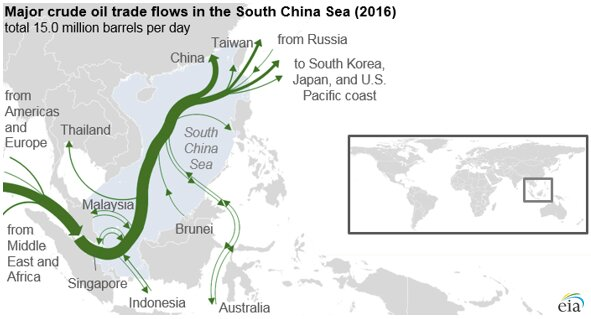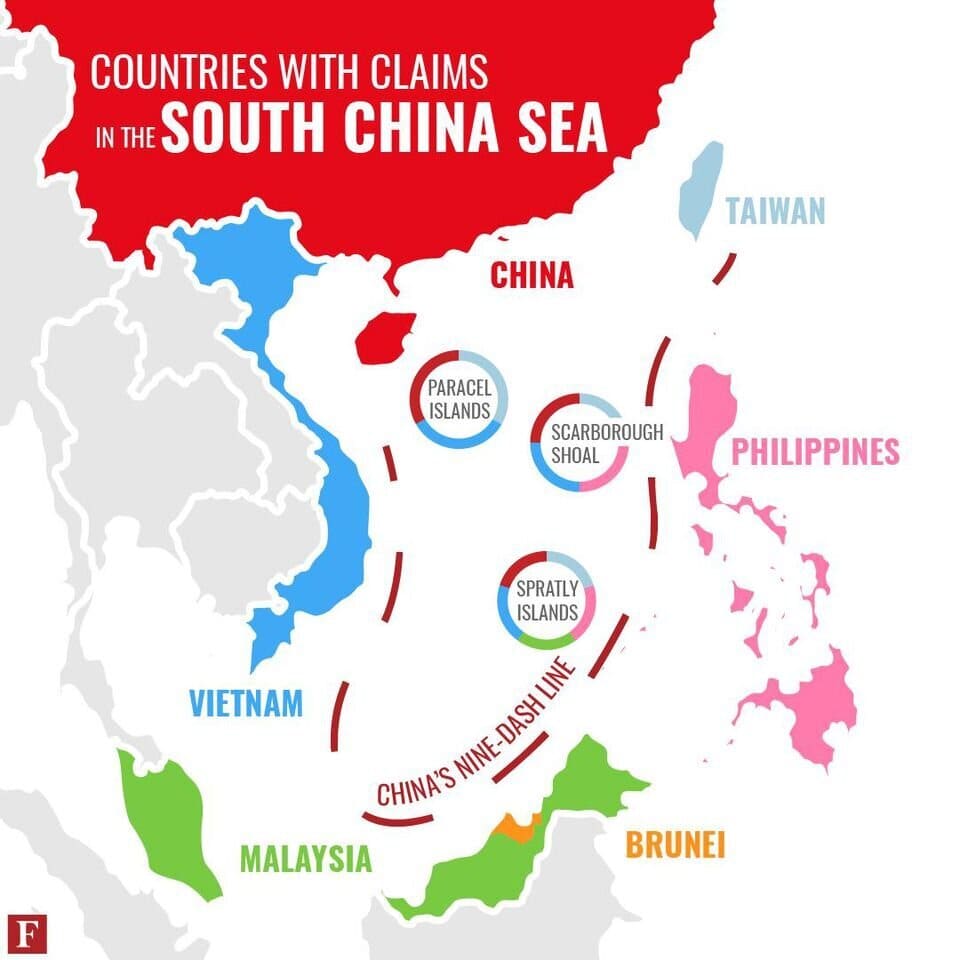China in South China Sea | 15 Apr 2020
This article is based on “South China Sea: Vietnam approaches UN against China” which was published in Times of India on 15/04/2020. It talks about China’s assertiveness and the corresponding disputes in the South China Sea.
Maritime Asia has emerged as a new geopolitical frame of reference in recent years as the nations of Asia evolve into major trading and resource-consuming powers with economic growth dependent on seaborne trade.
However, China has been aggressively expanding its maritime influence, which can be seen through its activities in the South China Sea (SCS).
The sinking of Vietnamese fishing boat (in the Exclusive Economic Zone of Vietnam) by a Chinese ship near the Paracel Islands is the recent act of aggression in the region. Earlier, China unilaterally refused to follow the ruling on SCS given by the Permanent Court of Arbitration in 2016.
These Chinese assertions in the South China Sea and its hegemonic ambitions have become a cause of concern for peace and stability in the region.
Significance of South China Sea
- Geo-Strategic Location
- The geographic location of the SCS is strategically important. As it links the Indian Ocean to the Pacific and is a critical shipping channel
- According to the United Nations Conference on Trade And Development (UNCTAD), one-third of the global shipping passes through it, carrying trillions of trade.
- Roughly two thirds of South Korea’s energy supplies, nearly 60% of Japan’s and Taiwan’s energy supplies, and 80% of China’s crude oil imports come through the South China Sea.
- Rich Energy Reserves
- SCS is believed to have huge oil and gas reserves beneath its seabed.
- According to the World Bank, the South China Sea holds proven oil reserves of at least seven billion barrels and an estimated 900 trillion cubic feet of natural gas.
- Choke Point
- The Strait of Malacca connects Indian Ocean to the South China Sea and is 900 km in length and is also a prominent trade route between East Asia and West Asia-Europe.
- The Strait of Malacca is a choke point, it is always in interest of great powers to control such a strategic location. Thus, due to the presence of this choke point, SCS assumes much importance for China and other regional countries.
- In context of naval diplomacy, it is a geopolitical term used to signify an international strait whose control could potentially affect commercial transit.
- Fishery Resources
- Fishing in the South China Sea is a big business.
- According to some estimates up to 10 % of the world’s ocean-caught fish come from the region. However the fish stocks in the area are depleted and regional countries are using fishing bans as a means of asserting their sovereignty claims.
South China Dispute
Encroaching EEZ of Other Countries
In 1947, China took control of some islets in the South China Sea occupied by Japan in World War–II. Since 1953, China has been claiming almost the entire South China Sea, reflected in a map created with a 9-dash line to show them as a part of China.
- In 2016, the Philippines had filed an arbitration case in the Permanent Court of Arbitration, seeking to strike down China’s expansive territorial claims in the South China Sea.
- The tribunal issued a decision finding that there is no legal basis to claim “historic rights” to islands in the South China Sea and the 9-dash line is inconsistent with Convention on the Law of the Sea.
- However, China refused to abide by the judgement.
- China has asserted a maritime claim (based on historic rights) to a large part of the South China Sea that is not consistent with international law.
- The SCS has more than a dozen overlapping EEZ in accordance with the 1982 Convention on the Law of the Sea (UNCLOS- an international treaty that sets out important maritime rules).
- As per UNCLOS, countries in their EEZ can explore oil, mineral resources, living and non-living natural resources including resources under the sea, seabed and subsoil.
Building Great Wall of Sand
There are many interconnected disputes over who is in charge of the various islands, rocks, shoals and reefs scattered throughout the South China Sea waters.
- The Paracel Islands are claimed by China, Taiwan and Vietnam. The Spratly Islands are claimed by China, Taiwan, Vietnam, Brunei and Philippines. The Scarborough Shoal is claimed by Philippines, China and Taiwan.
- Further, since 2010, China has been converting uninhabited islets into artificial islets to bring it under UNCLOS (examples would include Haven Reef, Johnson South Reef and Fiery Cross Reef).
- China has been changing the size and structure of the reefs by modifying their physical land features. It has also established airstrips on Parcel and Spratly.
- Chinese fishing fleets are “engaged in paramilitary work on behalf of the state rather than the commercial enterprise of fishing.
- The US is very critical of this building of artificial islands and terms these actions of China as building a ‘great wall of sand’.
India's Stand
- India has maintained that it is not a party to the SCS dispute and its presence in the SCS is not to contain China but for its own economic interests, especially that of its energy security needs.
- However, China’s increasing ability to decide and expand its role in the South China Sea has compelled India to reevaluate its approach on the issue.
- As a key element of the Act East Policy, India has started internationalizing disputes in the Indo-Pacific region to psychological pressure on irritants (the recent mentions of South China Sea dispute in bilateral statements between India-USA and India-France is a testimony to the fact).
- Further, India is aggressively using the soft tool of Buddhist legacy to reclaim the unique historical leverage to make a strong bond with the Southeast Asian region.
- India has also deployed its navy with Vietnam in the South China Sea for protection of sea lanes of communication (SLOC), denying China any space for assertion.
- Also, India is part of Quad initiative (India, US, Japan, Australia) and lynchpin of Indo-Pacific narrative. These initiatives are viewed as a containment strategy by China.
Conclusion
Today’s world comprises extensive interconnections of countries and people. Any particular conflict, therefore, has the potential to have a ripple effect on countries and institutions other than the direct stakeholders. China must realise that it cannot continue with its bullying tactics and win trust of its neighbours and respect from the International Community.It is therefore desirable that all the countries of this region should abide by rule based international order and peaceful coexistence.
|
Drishti Mains Question China’s aggressive posture in the South China Sea poses a strategic threat for India. Analyse. |


